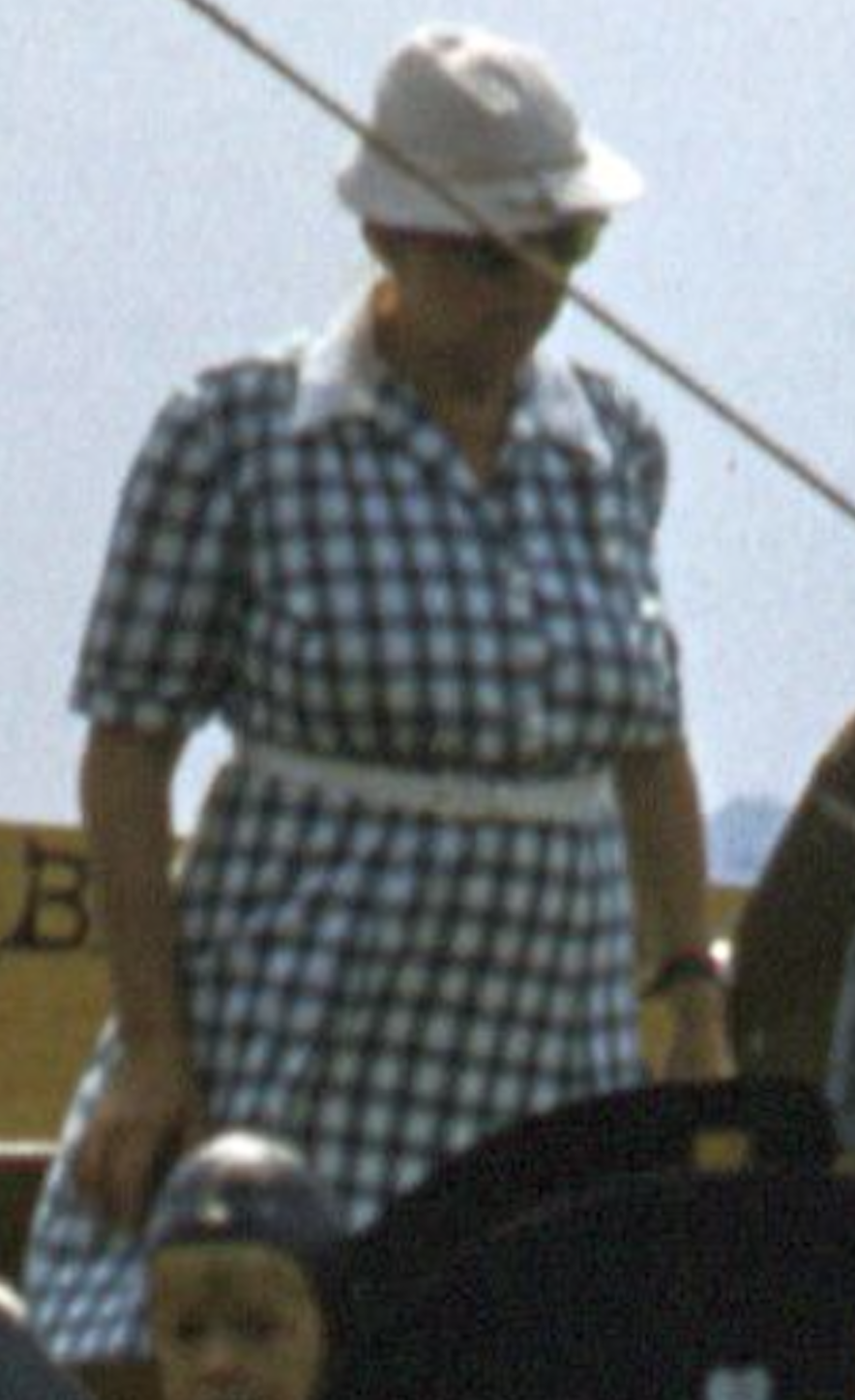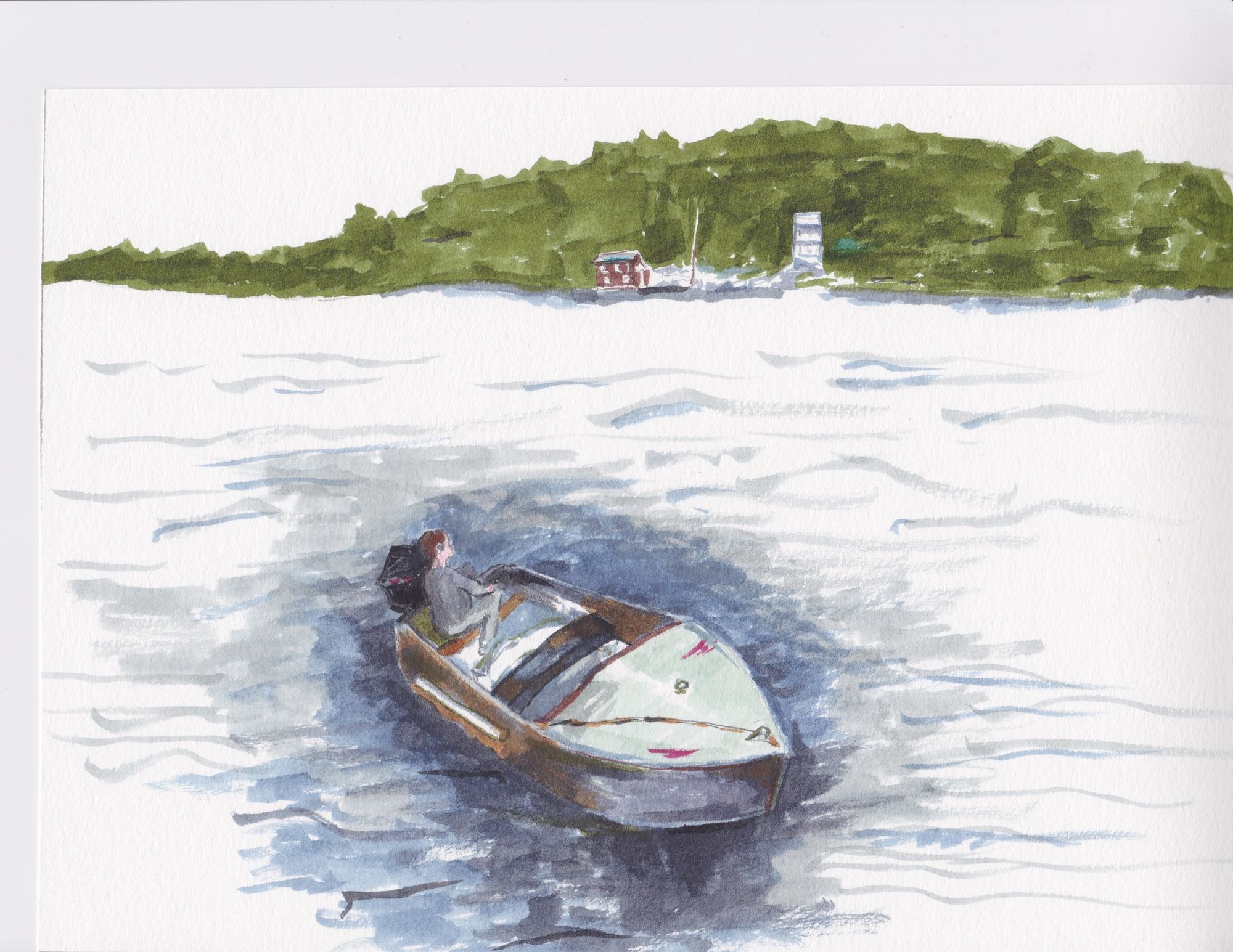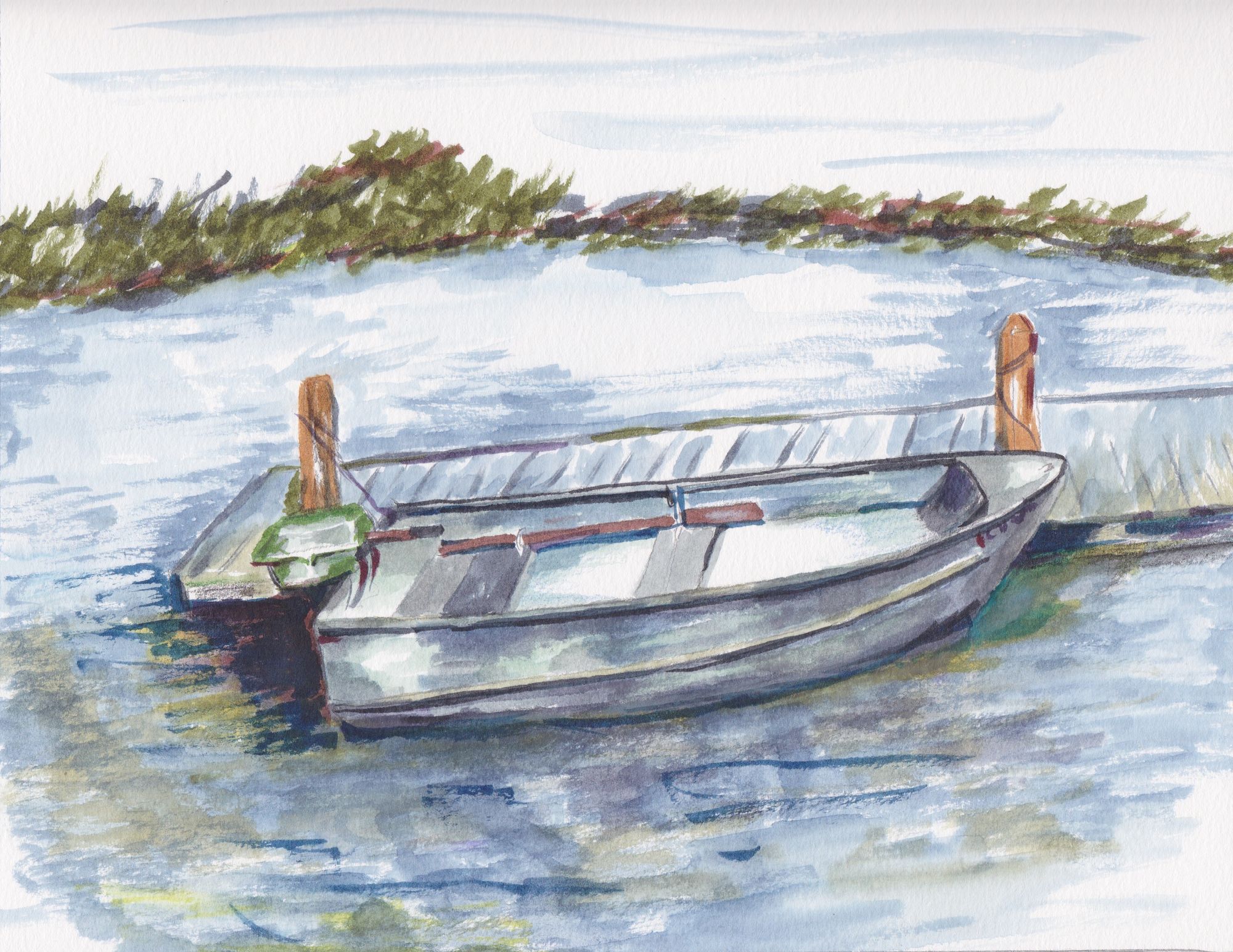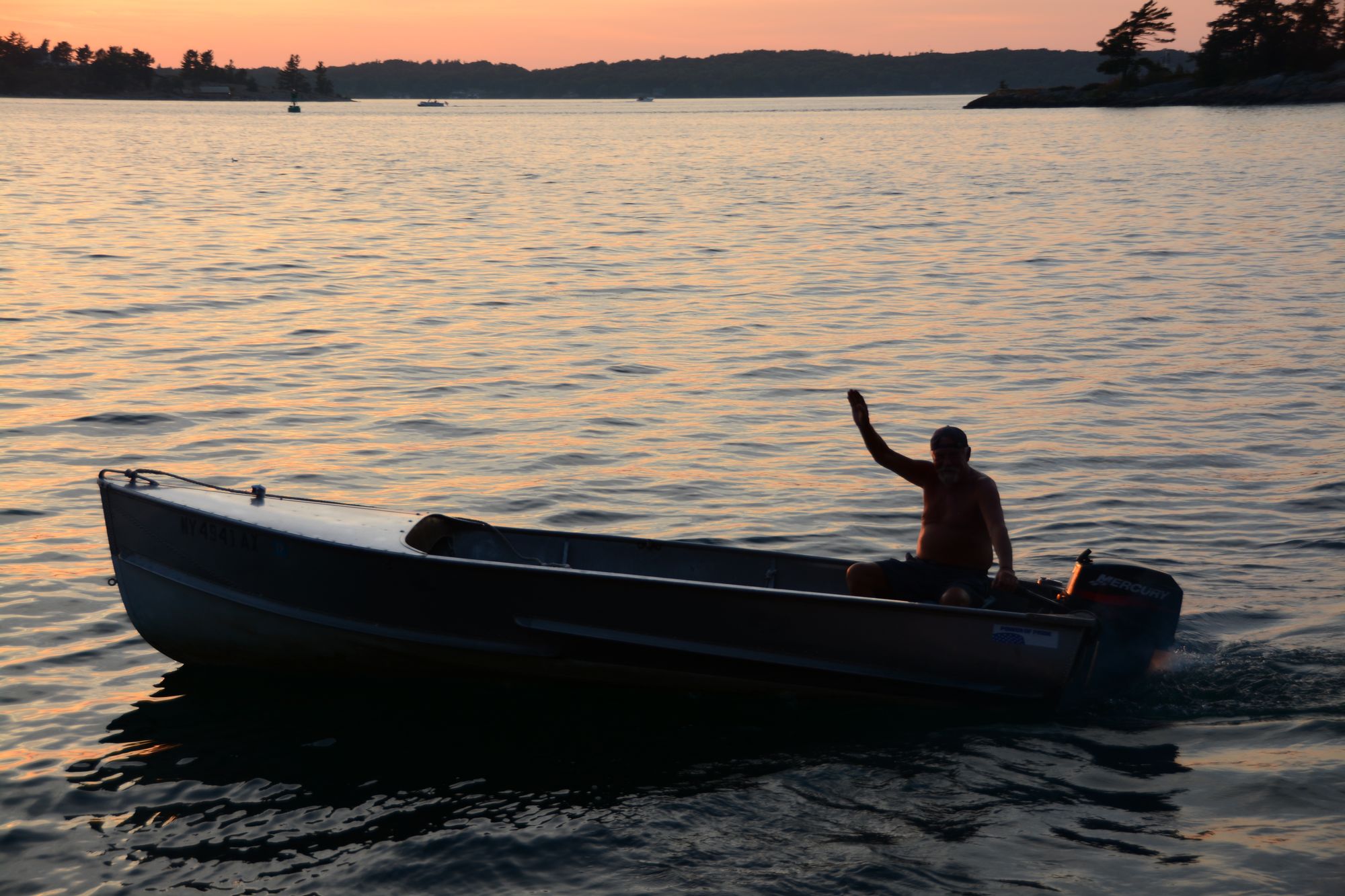They are still there to be found, if you look for them.
Not as many now as in years past perhaps, but some do remain on the River. They may be tied to an out-of-the-way dock … tucked away in a boathouse … or sadly, even left abandoned on the shore or in the water, destined to decay and die.
They are the old-fashioned, small, now often overlooked, boats that generations of River people have relied on for transportation—or just for fun. They are rowboats and outboards, sailboats and skiffs. They are the essence of the River.

One such craft—for lack of a better name, or any real name at all, for that matter—is The Little Red Punt.
The Little Red Punt has been in our family for four generations now. It lacks the sleek lines and the powerful engines and the fancy graphics that today’s boats boast. In fact, it’s rather ungainly. Some might even say ‘ugly’.

But what it’s missing by way of aesthetics, the punt more than makes up for in sturdiness. Square-ended at bow and stern, equipped only with two oars and no seat cushions, sitting low in the water and laden with countless coats of thick red paint applied over the decades, the punt has served as a faithful family member for longer than anyone today can remember.
It has carried everything from lumber and mechanical gear needed for life on an island, to kids and dogs and everything in between. It is, from all appearances and experiences, virtually indestructible. And evidently unsinkable, despite various determined efforts by mischievous children over the years to test its “Molly Brown” qualities. The Little Red Punt gently, patiently defied them all.
No one ‘needs’ a boat like The Little Red Punt today. Most probably wouldn’t even want one. Hand built with thick, wide planks, it is heavy as lead—but despite that, with one swing of an oar it can spin in place! It would gather no admiring glances at the gas dock—not that it would ever visit one in the first place! It can’t power you down the channel with a load of family or guests. Rainwater gathered on its flat bottom has to be bailed out by hand, with a manual pump; or more often, in the punt’s case, an old coffee can was be kept on board for this purpose—no modern electric bilge pump!
But it is still a long-beloved boat. Many, many happy memories of rowing around the small bay where it has lived its entire life are shared by multiple generations. For some, it was their first boating experience on the River. For all that, it is a treasure—maybe an old-fashioned, out-of-favor River relic by today’s standards—but a timeless treasure nonetheless.
Sharing a summer home with The Little Red Punt was its smaller, much daintier, more sophisticated, and prettier-by-far ‘cousin’: the Peapod.
A pure wooden rowboat by elegant design, the Peapod looked just as its name implies—forest green on the outside, its interior was beautifully sculpted and varnished to a perfect golden hue. It resembled a peapod opened to reveal its inner self. As light and easily maneuvered as the punt was heavy to get underway, the Peapod belonged to Emily Post, our great aunt and the founder of the Thousand Islands Museum Craft School (now the Thousand Islands Art Center).


No adult ever thought to toss a bag of cement or a load of lumber in the Peapod. Likewise, no child ever considered testing its flotation capabilities. It was a delicate (by boat standards) craft, made for simple rowing outings on a classically calm River day, to be enjoyed with at most a passenger or two aboard. One instinctively sat upright in the Peapod—her well-mannered bearing quietly called for it.
It was as beautiful as The Little Red Punt was homely. And it, too, was a true River classic.
And then there is the Small Fry. This short aluminum outboard defines “durability”.
Its provenance is unknown. Apparently, at some point in its long and checkered life, it sported red paint on its brief bow deck. Only archeological traces of that paint now remain.
Likewise for what were once varnished wooden seats. Today, no varnish survives—and hasn’t in several decades’ worth of recollection.
The Small Fry was the daily transportation for Henry Custis Jr., a lifelong summer resident on Grindstone Island. It survived its entire life outdoors, tethered to a dock, season after season, through storms and sun—hence its well-weathered livery.

Standing in sharp contrast to the beautiful Hutchinson sedan that was the family’s main boat, and which was Henry’s other favorite, the Small Fry is the quintessential example of the small aluminum outboards that once were everywhere on the River in the mid-through-later 20th century.
They were workboats, ferrying supplies and people back and forth from mainland to island. They were recreational craft, light and fast. They were largely immune to damage—you could pull them up on a rocky shoreline and not have to worry much about injury to the hull.

They were the ‘first boat’ for many youngsters back then. They were typically powered by 10-25 horsepower Johnson, Evinrude, and in far fewer cases, Mercury outboard engines. But they also usually had oars aboard. Long before someone could be licensed to drive a car, kids could jump into their ‘tin boat’ (as they were sometimes called), and find precious freedom and independence cruising the River. A particular rite of passage—wholly unknown to most today—was mixing oil into the gas tank. Basic lessons in pints and gallons were learned.
As seemingly ubiquitous as they once were, you see far fewer of these small aluminum outboards on the River now. Fiberglass has long replaced rivets. The Small Fry is a true survivor—and it shows.
My sister Sarah and I smile with the fondest of memories of Henry and the Small Fry. For decades, the battery-powered running lights were inoperable. He simply ignored changing the ancient expired batteries and therefore didn’t drive it after dark. Likewise with a replacement seat—it sat on the floor uninstalled for a similar length of time.
In his final years on the St. Lawrence, Henry drove the Small Fry with an outboard engine that he had purchased for all of $20. He was immensely proud of such a ‘deal’—despite the fact that the long-exhausted engine belched copious clouds of oily smoke every time he started it up.

One final image of these boats still lingers in mind. Many years ago, going past the marshlands at the head of Grindstone, out of the corner of my eye, through the gently waving rushes, I caught a momentary glimpse of just the bow of a small wooden boat. It had sunk—or perhaps been scuttled—far back in that swampy water. All that remained was that still-proud point of a bow, sticking up skyward just above the water, seemingly resolute in its desire to survive.

At some undefined point in time to come, these once-common boats will cease to exist, at least in any meaningful way, except perhaps in museums. Even then, it’s hard to imagine a boat like the punt, or the Small Fry, ever attaining exalted museum status.
Then, another River tradition will become a legacy of memories only. For those of us who experienced and enjoyed them though, they will take on the mantle of beloved legends, reminiscent of a certain era on the St. Lawrence that will have passed forever.

By Tom Robbins and illustrated by Sarah Coate
A third-generation summer resident of the Thousand Islands, Tom Robbin's career has taken him from the White House to Madison Avenue, Hollywood, and now Silicon Valley. His lifelong love of the St. Lawrence parallels his personal and professional interests in film production, photography, and writing. See Tom's TI Life articles here.
Sarah Coate is a lifelong River Rat; she attended the Rhode Island School of Design and owns a marketing company for tv commercial production companies. Sarah is also Tom's big sister! (Lucky guy, eh!)
Posted in: Volume 16, Issue 2, February 2021, History, Sports
Please click here if you are unable to post your comment.
